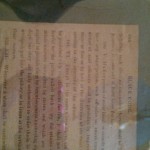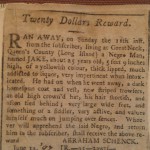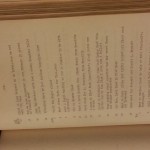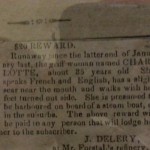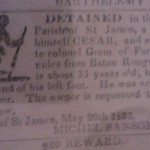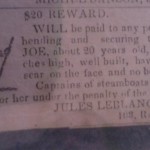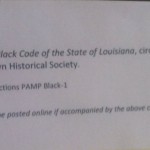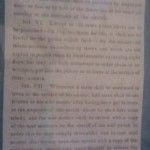At our last visit to the Brooklyn Historical Society, we looked at runaway slave advertisements in newspapers. As a group, we looked at two different documents that both contained these ads, and we had the chance to compare and contrast what we saw here with our reading experiences in the novel “Beloved” by Toni Morrison, as well as Franklin/Schwinger’s “Runaway Slave Profile.” Our group came up with some interesting observations between all of the texts that we analyzed, as well as differences that we noticed.
The first document that we looked at was a typescript journal of John Baxter of Flatlands, Long Island; a slave owner. These were some of the observations we made.
-the document was a big green book and the pages of it looked somewhat delicate, which indicates that it was old
-it was published in Brooklyn, NY 1955
-It was from the time periods of 1805- May 1817
-the farm that he owned was located in Flatlands, Long Island
-in page 21 of the journal; from July-Sept of 1807 we read events that go on in the man’s life and at the barn he owned
-He states that a slave ran off- of the name Abraham Wyckoff
-in page 133 of the journal; from April-June of 1815, Mr. Baxter’s “negro ran away” as he states on May 19th
– Mr. Baxter went to the town to publish an ad for his runaway slave, with a reward of $80 on May 22
The second document that we looked at was a runaway slave ad in a newspaper
-A.H Inskeep was the one who put up the ad
-it was for a mulatto named George of about 22 years of age
-he was described as tall and slender
-it cautioned all persons not to harbor or employ said boy
-it was estimated that the boy ran away June 2-3
Drawing a comparison between the documents that we looked at and our other source, there were many points of similarity. Franklin/Schweninger’s “Runaway slave profile” gave the age range of slaves likely to escape between the late twenties to early thirties and are usually male, and in the advertisement for the mulatto named George he falls into that category; being shown in the ad that he is 22 years old, still in his twenties. Also in the “runaway slave profile” it gives a few examples of different slave reward ads that are very similar to the ad for George in the newspaper. The ads usually start with a runaway slave or negro man and followed by the day the slaved escaped, then with a description of the slave, the height, skin color; whether they were dark or light skinned usually called mulattos, but they were also called yellow, light bacon, light copper. Also, what the slave was wearing and any significant or unique features to make the slaves easily identifiable such as scars, following a reward.
There were also some differences in these documents that we closely examined. In the “runaway slave profile” not only does it show that African slaves in the South were the most likely to run, but that there was more ethnic diversities than that of the North. Slaves were usually bilingual, spoke Spanish and English and may also have spoken French. The slaves in the north were also more educated and often knew trades that they were employed in. One ad in the South stated that a creole slave ran away and these were often called negrees. The ads usually described these slaves as ‘American creole’, ‘American mulatto’ or ‘American negro’.
The documents that we studied can also be compared to the runaway stories that we read of the characters in “Beloved.” What is interesting in “Beloved” is that Sethe was pregnant with Denver at the time she ran away, but in the “runaway slave profile”, it indicated that women were less likely to run because they would not want to leave their children behind. It also indicated that most of those who ran were strong because the escape was quite rough. This action by Sethe tells us a lot about her character. It gives quite an understanding on how her struggles had an effect on her ultimate decision, and courage to run.
There was no obvious mention of an advertisement by Mr. Garner when Howard, Burglar or any of the ‘Sweet Home’ men ran away. So it will be quite difficult to relate the two in this regard but obviously, many of the characters in who ran away in “Beloved” must share a lot of the characteristics with the typical runaway slave described in the “runaway slave profile”.


